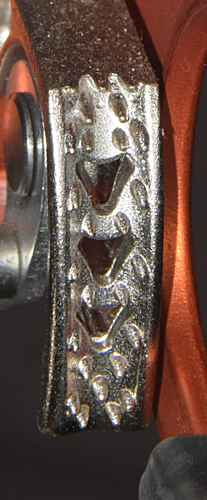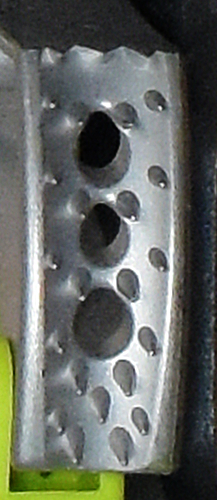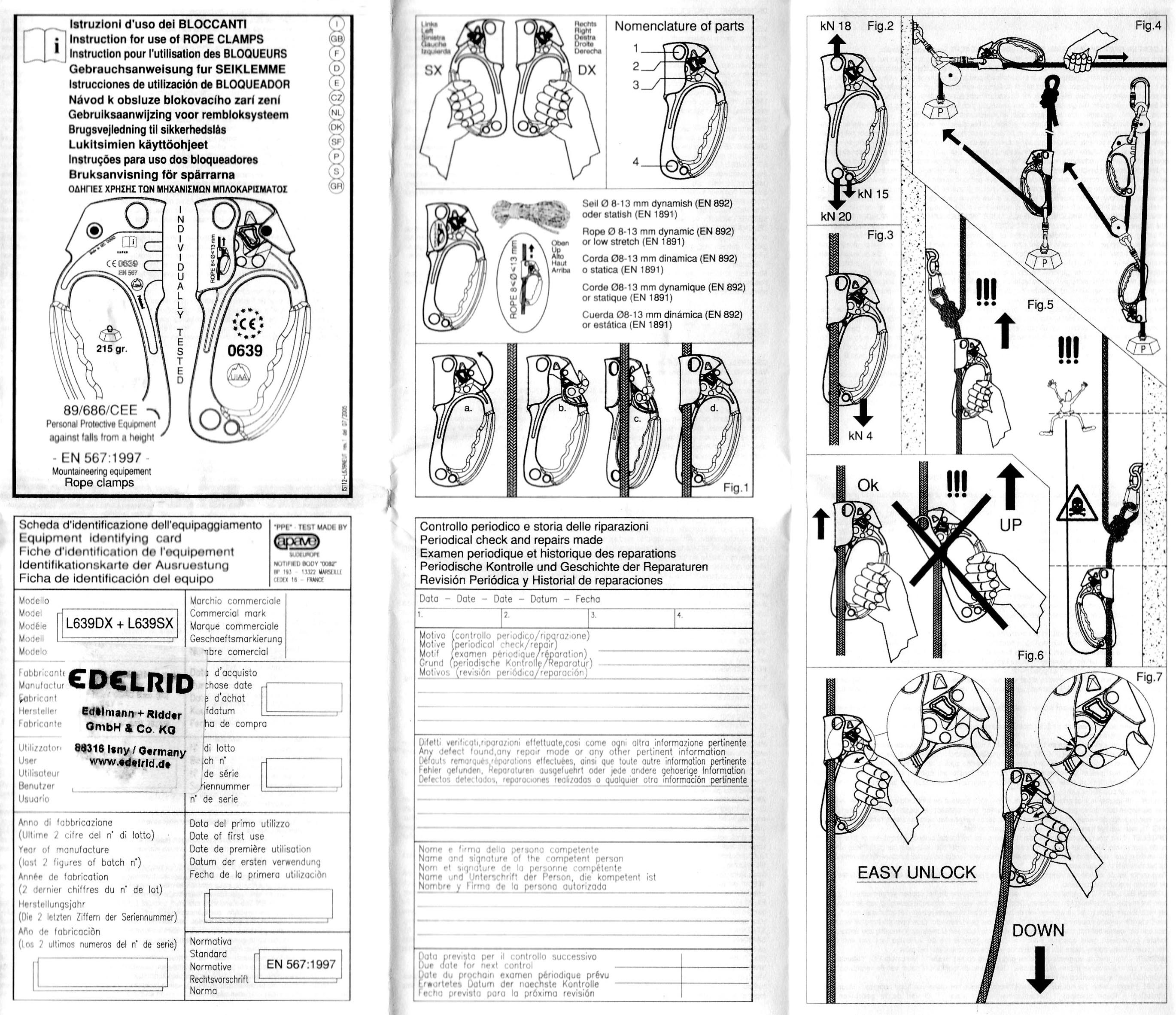Overview
[ Top
| Hand Cruiser
| Return to H.E.C. Ascenders
]
Elevator
(#220)
Technical Details
I acquired this pair of ascenders from Walkhigh Mountaineering
in May 2007.
 The shell is a tall irregular shaped stamping made from 4.0 mm. aluminum alloy sheet metal. A rope channel is formed in the
upper portion of one side and a smaller cam channel lies opposite
the first. A hole drilled through both sides of the cam channel
accepts a 5 mm. rivet. The cam and cam spring are mounted
on this rivet. The handle below the cam has a soft "rubbery"
hand grip molded into place. The hand grip has four shallow finger
grooves. A 14.8 mm. sling attachment hole is punched below
the handle opening, and a 9.8 mm. hole is punched outside
the first. A 15.7 by 18.7 mm. pear shaped hole through both
sides of the rope channel provides an attachment point just above
the cam. There is a punched cam stop just above the cam.
The shell is a tall irregular shaped stamping made from 4.0 mm. aluminum alloy sheet metal. A rope channel is formed in the
upper portion of one side and a smaller cam channel lies opposite
the first. A hole drilled through both sides of the cam channel
accepts a 5 mm. rivet. The cam and cam spring are mounted
on this rivet. The handle below the cam has a soft "rubbery"
hand grip molded into place. The hand grip has four shallow finger
grooves. A 14.8 mm. sling attachment hole is punched below
the handle opening, and a 9.8 mm. hole is punched outside
the first. A 15.7 by 18.7 mm. pear shaped hole through both
sides of the rope channel provides an attachment point just above
the cam. There is a punched cam stop just above the cam.
This ascender uses a standard
Climbing Technology cam found on many of their handled and handleless eccentric cam ascenders.
The cam is a plated skeletonized steel casting. The cam radius,
measured from the pivot, increases from 38 to 57 mm. over
an angle of 40°, giving a 31° cam angle. The cam has number
of small conical teeth, all of which have their axes approximately
parallel to the lower surface of the cam. The tooth pattern is
(3.2.4)(1H1.2)^3(3.2), where the "H" stands for a 4 mm. wide, 6 mm.
wide inverted subtriangular hole.
A spring-loaded manual safety
is mounted on an axle riveted to the center of the cam.
The normal action of the spring holds the safety against the cam.
When the cam is opened, the shell interferes with
the safety tab, thus preventing opening the cam. If the safety
is moved away from the cam (opposing the spring), the tab will
clear the shell and the cam will open. At full open the safety
can be released and the spring will hold the arm against the back of the shell, locking the cam
open.
The front of ascenders are printed with an icon showing the
ascender on rope, an arrow pointing up, and "ROPE 8<Ø<13mm."
The back is printed with "CT Made in EEC 0205," a book
icon with an "i" on the right-hand page, "EDELRID,"
"CE0639," "EN 567," the UIAA logo, and "Patented." The cam on the left ascender has "L1" in raised letters, while the right-hand ascender cam has "L2."
The Edelrid Elevator is one of the following group of ascenders, all of which are variations of the same basic design using the same cam safety style:
Climbing Technology Ltd. of Cisano Bergamasco, Italy made all of these ascenders. Climbing Technology
also made a version of the Amelia for Repetto Sport,
but I never acquired that version.
These are well-made ascenders and
perform much like the Petzl Ascension.
All sharp edges have been removed. The attachment points are simple
yet well-rounded holes in the shell; even so, I would consider
their small radius too sharp for directly attaching sling ropes.
They are probably acceptably rounded for webbing, but considering
the proximity of the attachment points to the main rope, I would
recommend using a small maillon for most attachments in order
to reduce the risk of sling abrasion. The lower attachment hole
could theoretically have the same safety problems as the one described for the
Clog Version B.
The upper rope attachment
hole is located very close to the main rope. A carabiner through
the upper attachment hole will probably drag on the main line.
Note that such a carabiner will prevent putting the ascender on
or off rope, so one's climbing system must be designed accordingly.
The safety is one of the easiest to use with one hand. It reminds
me of the one on the Hugh Banner and
the PMI Cat, but the ones on these are smoother. The "thumbing" feature is clever but does
not work well on ropes larger than about 11 mm: the cam does
not open enough for the down-sloping teeth to reliably miss catching
on the rope sheath. I think it is better to simply grasp the ascender
from above and lift the ascender in the traditional manner (unless, of course, you are one of those who prefers to climb Frog). The
ribbed handle is comfortable enough for my large hands, but I
don't climb by gripping ascenders at their handle.
The rubber handle grips have evolved with time. They are not particularly comfortable for me because the ribs are spaced
poorly for my large hands. In addition, the handle on the older models is "too square" for my taste. A file
can eliminate both objections, but I suspect that few people will find a need to modify theirs.
The cam is very well made. The cam stop is placed in a position
where it will actually touch the cam if the ascender is off rope.
Many manufacturers put cam stops in odd places where they can
never touch the cam. I don't see much need for cam stops, most
active cavers don't weight enough to bend their ascenders to failure
by cam pull-through, and there is no need to shock load one's
ascenders.
The small pin on the cam safety performs an interesting function: pushing down on the ring (or post) causes the safety tab to lever the cam open, but not enough to let the rope free. This provides an alternate way to "thumb" the ascender.
The cam closing stop contacts the cam at the same time that the cam face contacts the inside of the rope groove. In any case, the stop only functions when the ascender is off rope, so I consider it to be superfluous. Its only purpose is to achieve a higher strength in artificial tests prescribed by various standards.
The holes in the cam face are intended to reduce the risk of ascender slippage due to mud-caked cam teeth. The design appears superior to some, but most ropes muddy enough to stop other ascenders will stop the this one as well. If you climb muddy ropes, expect to encounter slipping problems with any eccentric cam ascender.
This ascender has the same pit lip disadvantage as the
Clog and other stamped frame ascenders,
although the reinforcing will help prevent bending.
I'm not sure the extra holes are needed at the base. Except for the Petzl Pompe, I've never found a real need for a second hole. Some people like them, and I might find them more appealing if they were large enough for a standard carabiner to fit through.
If you are looking for a stamped-frame handled ascender, any of these would be a good choice.
[ Top
| Elevator
| Return to H.E.C. Ascenders
]
Hand Cruiser
(#3542/3507)
Technical Details
I acquired my Edelrid Hand Cruisers from CanyonZone.com - Gertjan van Pelt in 2022.
The Edelrid Hand Cruiser is 188 mm. tall, 103 mm. wide, 34 mm. thick, and weighs 201 g. The rope channel is 14 mm. wide. The cam axle is centered 41 mm. from the inside of the rope channel. The cam radius increases from 30 to 46 mm. over an angle of 40°, giving a 31° cam angle. The tooth pattern is (3.2)(2.1H1)^3(2.3.2).
 The shell is a tall irregular shaped stamping made from 4.0 mm. aluminum alloy sheet metal. A 14 mm. wide rope channel is formed in the
upper portion of one side and a smaller cam channel lies opposite
the first. A hole drilled through both sides of the cam channel
accepts a 5 mm. rivet. The cam and cam spring are mounted
on this rivet. The cam axle is centered 41 mm. from the inside of the rope channel. The handle below the cam has a soft "rubbery"
hand grip molded into place. The hand grip has thirteen shallow grooves to provide a more secure grip for the hand. An irregular 43 mm. wide, 21 mm. high sling attachment hole is punched below
the handle opening, and an irregular 35 mm. tall, 15 mm. wide hole is punched in the front strap. A round 15.6 mm.hole, distorted by the cam channel bend, provides an attachment point just above
the cam. There is no cam stop.
The shell is a tall irregular shaped stamping made from 4.0 mm. aluminum alloy sheet metal. A 14 mm. wide rope channel is formed in the
upper portion of one side and a smaller cam channel lies opposite
the first. A hole drilled through both sides of the cam channel
accepts a 5 mm. rivet. The cam and cam spring are mounted
on this rivet. The cam axle is centered 41 mm. from the inside of the rope channel. The handle below the cam has a soft "rubbery"
hand grip molded into place. The hand grip has thirteen shallow grooves to provide a more secure grip for the hand. An irregular 43 mm. wide, 21 mm. high sling attachment hole is punched below
the handle opening, and an irregular 35 mm. tall, 15 mm. wide hole is punched in the front strap. A round 15.6 mm.hole, distorted by the cam channel bend, provides an attachment point just above
the cam. There is no cam stop.
The cam is a stainless steel casting. The cam radius increases from 30 to 46 mm. over an angle of 40°, giving a 31° cam angle. The cam has number of small conical teeth, all of which have their axes approximately parallel to the lower surface of the cam. The tooth pattern is (3.2)(2.1H1)^3(2.3.2), where the "H" stands for an oval hole. The top and bottom holes are 4.4 mm. tall and 3.5 mm. wide, while the center hole is about 0.3 mm. smaller in both directions. A spring-loaded plastic manual safety is mounted on an axle riveted to a tab on the bottom of the cam. The normal action of the spring holds the safety against the cam. A 9.9 mm. tall, 7.4 mm diameter pin is riveted below the cam channel. When the cam is opened, the pin interferes with the safety tab, thus preventing opening the cam. If the safety is moved away from the cam (opposing the spring), the tab will clear the pin and the cam will open. At full open the safety can be released and the spring will hold the safety behind the pin, locking the cam open.
The front of ascenders are printed "EDELRID" and "HANDCRUISER." The rear is printed with "CE2777," a book-with-an-"i" icon, "EN 12841:2006-B 150kg•Ø10-13 mm.," "EN567:2013 Ø8-18 mm," "EDELRID," "Achener Weig 66," "88316 Isny i.A., Germany," a factory icon, "2021 04 Y ACC", UP,", and a large "↑."
The right-hand Hand Cruiser became available from the Manufacturer in January 2022, and the left-hand version was available in July.
The Hand Cruiser is a well-made ascender, and one-handed operation is exceptionally smooth. This is one of the best handled ascender for one-handed operation, at least for my large hands. The
ribbed handle is comfortable enough for my large hands, but I
don't climb by gripping ascenders at their handle. I think it is better to simply grasp the ascender from above and lift the ascender in the traditional manner (unless, of course, you are one of those who prefers to climb Frog). Replacing finger grooves with a ribbed surface was a welcome change, since finger grooves only align with fingers if your hands are sized to match the ascender. Mine seldom are.
The lower attachment hole is irregular. I don't see an advantage to this shape. Slings tied here will tend to slide back and forth, accelerating their wear on the narrow frame. I would consider its small radius too sharp for directly attaching sling ropes. A maillon attachment will help eliminate sling wear, but the maillon will slide back and forth as one climbs. This may be annoying.
The irregular opening in the front strap has no obvious purpose. I think its position and shape is more cosmetic than functional.
The upper rope attachment hole is located very close to the main rope. A carabiner through the upper attachment hole will probably drag on the main line. Such a carabiner will prevent putting the ascender on or off rope, so one's climbing system must be designed accordingly.
The cam is smaller than most ascender cams, reflecting recent trends. It is also very well made. The down-sloping teeth are beautifully formed. The holes in the cam face are intended to reduce the risk of ascender slippage due to mud-caked cam teeth. The design appears superior to some, but most ropes muddy enough to stop other ascenders will stop the this one as well. If you climb muddy ropes, expect to encounter slipping problems with any eccentric cam ascender.
[ Top
| Elevator
| Hand Cruiser
]



